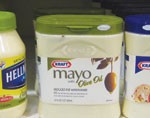| Designing For Retail Realities |
Brand marketers can no longer afford to ignore the way packaging appears in the ‘real world.’
by Scott Young and Jonathan Asher, Brand Packaging, August 31, 2009

For years, we’ve advised marketers to ensure their packaging “breaks through shelf clutter” and facilitates shopping. That’s because our studies have consistently shown that visibility and shoppability are most predictive of in-market success.
But all it takes is one walk down a store aisle—whether it’s a Walmart in Texas, a kiosk in Jakarta or a hypermarket in Paris—to realize that we need to take our advice one step further. To ensure success, marketers must not only optimize visibility and shoppability but also how packaging actually appears on the shelf.
We’re speaking, of course, about a fundamental and nearly-universal truth: Packaging rarely appears as we’d like it to at retail. Instead, packages are frequently knocked over, facing sideways or backwards, partially obstructed, scrunched up or dented, or compromised by poor lighting or careless stocking.
What’s more, many marketers willfully ignore these “retail realities.” The situation is frequently dismissed as “beyond our control” or “different in every store” or simply, “someone else’s responsibility.”
But marketers can no longer afford to think and act this way. With more than two-thirds of purchase decisions made in-store—and with retailers increasingly focused on aggressively promoting their own store brands—ignoring “retail realities” is costing brands millions in forgone sales.
Tackling the situation becomes more manageable, though, when marketers think more systematically about the realities of the retail environment.
Packaging issues
To begin, there are the packaging issues—the result of packaging systems or structures that don’t always translate well to the retail environment.
Consider rounded containers. They look great in the conference room (or when viewed in a focus group) when they face directly forward, but, in-store these containers are often turned off-center, which can greatly compromise their impact and communication. Bagged products can also be a challenge because they are likely to sag or get “scrunched” on shelf, which can impact quality perceptions and/or make key copy points (claims, variety, etc.) unreadable.
Sometimes, a packaging material can be a detriment, even if it was expressly intended as a consumer benefit. For example, many packages use a clear window to allow the shopper to view the product. However, when these windows are damaged—as is known to happen—the product becomes compromised and the result is a package that cannot be sold.
The visual impact of some colors is also a packaging challenge, particularly white or black packs because they are far more likely to be influenced by shelving, the quality of lighting and other elements of the retail environment.
Shelving issues
There are also considerable issues with the way packaging is presented within a category. Though marketers may not be able to control the shelf, they can anticipate the different possibilities and design accordingly.
For example, a package’s location on shelf has a direct impact on how it is viewed by the shopper, and, as a result, the importance of different panels. If a package is typically placed on lower shelves (or within refrigerator wells), it is typically viewed downward which makes the top panel (or lid) the primary communication vehicle.
The way a category is organized also impacts packaging communication. In a category where private label is interspersed with national brands, the primary packaging challenge often becomes one of differentiation and the justification of a price premium. In brand-blocked categories, there is a greater need to visually pre-empt the competition and facilitate product selection within the brand.
Another shelving concern relates to the manner in which the category is actually stocked. For example, retailers often put out as much product as possible to save time and minimize stock-outs. Extra packages may be stuffed on shelf, leading to scrunched/compromised packs. Side or end panels may be featured (as is often the case in the pet aisle), which places greater importance for these panels to “sell” for the brand.
There’s also the unfortunate reality that some stores may fail to accurately follow any prescribed planogram—and, thus, may not place a brand’s packages in anticipated or desired adjacencies.
Merchandising issues
On a broader scale, there are other in-store variables that are cause for concern: product displays, signage and promotions, and retail environments are merchandising issues that can all dramatically impact packaging effectiveness.
The presence of product or point-of-sale displays, for instance, can dramatically impact the role of packaging. Consider the various technology categories, where products are often displayed without packaging. When the shopper does reach for the packaging, it is to quickly and clearly confirm product specifications and compatibility (i.e., Will it work with my system?).
In these instances, it’s important that packages and in-store displays peacefully coexist, by complementing each other rather than replicating efforts. We’ve found that displays can be effective in driving shopper attention and conveying a strong brand message, while packages are typically better suited to conveying specific product benefits and facilitating shopping/selection.
Merchandising issues also include the many different physical impediments that can compromise packaging communication. These include shelf “lips” that can block the bottom portion of a package, shelf overhangs that can obstruct the top—or even freezer doors that often fog up and hinder package viewing.



